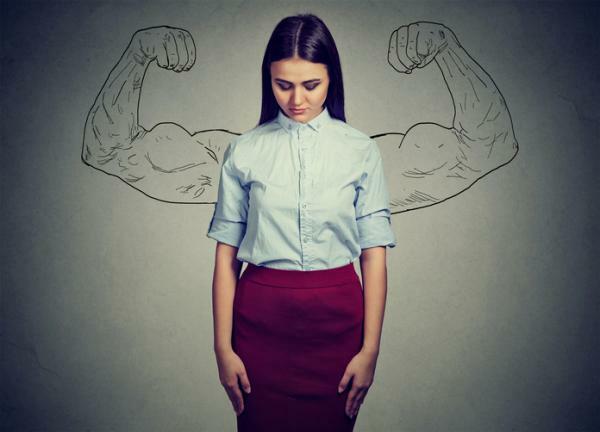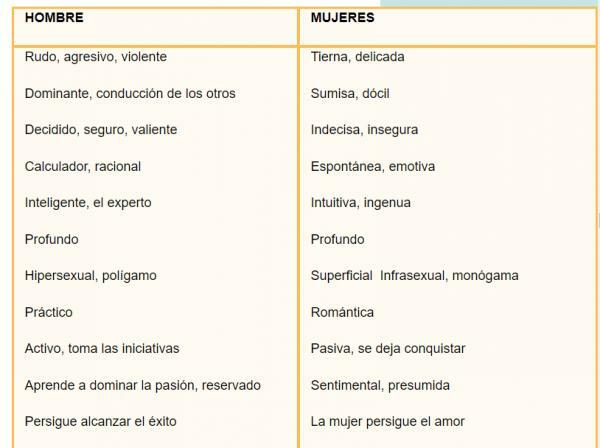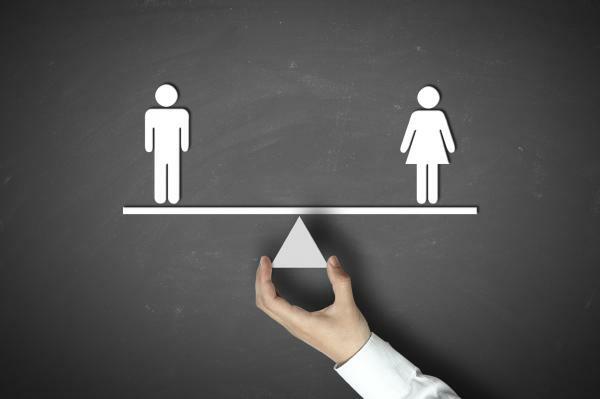
Male domination is so anchored in our unconscious that we no longer perceive it, so in accordance with what we hope that we have difficulty questioning it. More than ever, it is essential to dissolve the evidence and explore the symbolic structures of the androcentric unconscious, which survives in men and women (...) Pierre Bourdieu
It is important to put on the table Some Reflections on GenderIf you are interested or interested in it, we invite you to read the following PsicologíaOnline article.
Index
- The patriarchy or model of male domination
- Some considerations on the concept of gender
- Gender roles
- The masculine and feminine in contemporary society
- Some considerations about masculinity
- Some considerations about the current feminine reality
- Gender stereotypes
- Changes in the conception of current femininity and masculinity
- Rules of the game for men who want to love new women (excerpts)
The patriarchy or model of male domination.
Patriarchy, machismo, strong man, weak and submissive woman. Who has not ever stopped to think about these concepts, what they represent in our lives from our being men or women, or at least have heard a heated discussion around this? Who has not ever gone through the laughable situation in which they discuss, "jokingly", about privileges and weaknesses of each gender, trying to identify the weaker and stronger sex where the unknown of the chicken and the egg seems to be repeated, because in the end, nobody is right? Perhaps you are wondering at this time what relationship may exist between the previous questions, or why we refer to these aspects of daily life. In the course of this article, we will address in a general way the power relations between the genders and the ideology that sustains them.
The term patriarchy is created by feminist theory in the seventies, although its essence has accompanied the human being since much older times. In this sense it has been private property, the driving force behind the emergence and support of the patriarchal order, bringing with it profound transformations in the structure and dynamics of the family and marriage, thus establishing rigid hierarchical relationships that limit the potentialities and rights of sex feminine. His "power" was reduced to the private area, more specifically to the domestic, to the maternal and to the affections, depriving her of the enjoyment of social, sexual, work, intellectual life, among others restrictions. In this way, a new form of social discrimination is imposed in the history of humanity.
To the exclusion of people due to their race, social class, geographical location is added stereotypical differentiation of the sexes, assigning power to the masculine and submission to the feminine, and what is worse, it has been rooted in the subjectivities presenting itself as something unquestionable, natural, legitimate, although with some emerging changes in patriarchal society contemporary.
I start from the fact that it constitutes a power structure that determines interactions between genders, with the same sex and with oneself. This power structure, as its name indicates, is essentially male and its influence has encompassed the most diverse spaces such as politics, the economy, the family, the couple, etc.
“It is the structural set of social practices and ideological representations. Terms such as sexism and machismo do not seem to sufficiently cover the field of phenomena involved. They suggest ideology or individual practice more than structures and their character as a system. " (Medina, S., 2003)
B. Castellanos and A. González, in his book "Sexuality and genders" divide the influence of patriarchy into two fundamental periods: traditional and contemporary patriarchal societies. In the former, male predominance arises and relations of power, subordination and discrimination appear in relation to women from a double moral, where a separation of the roles and functions of both is made in society, the eroticism of the man is exalted while that of the woman is inhibited reducing it to reproductive purposes in the matrimonial context and where prostitution constitutes the only way of economic independence of the woman of that epoch.
For its part, in contemporary societies the social structure continues to be androcentric although with a less rigid application of traditional double standards, beginning a redefinition of values and more flexible and humane sexual models, a new meaning is built of female eroticism regardless of marriage and reproduction, although it continues to be discriminated against from other ways. There is also evidence of a progressive modification of attitudes in the relationships between the sexes. Finally, the authors point out that with the advent of this new form of patriarchy there is a confrontation between traditional models and values with current ones.
The transition to a contemporary form of patriarchy is mainly due to the advent of the Industrial Revolution, technological advances and the need for the incorporation of women into the labor sphere. Thus, progressively, they begin to perform tasks that were conventionally exclusive to men. The Sexual Revolution contributed greatly to the transformation of socially established sexual models, especially with regard to marriage, female eroticism, sexual pleasure, greater performance in courtship and access to certain sexual rights for the woman. There is an overcoming of antisexual values, myths, double standards, defining a different encounter between the sexes in the love and sexual sphere.
Some considerations on the concept of gender.
The issue of gender has been approached throughout history by various disciplines and specialists. It would constitute a treatise if we tried to gather all the wealth of criteria and controversies that have characterized its study, even, if we take into account that centuries before its conceptualization there were already some criteria of thinkers illustrious. It is a subject that has occupied the human being from the moment that men and women have established relationships in a certain society, no matter how old it may be.
Not in all the times in which the human being has lived under a certain social organization nor in all cultures and civilizations has man been the privileged, the provider of a dominance over the female sex. It is said that in primitive societies a greater spontaneity and a predominantly equitable character prevailed in the relations between the sexes, differentiated only by the type of activity due to distinctions anatomophysiological.
Some years ago, John Money in search of a term that could systematize the social expression of sexuality and could concentrate it in terms of the man-woman relationship, introduced for the first time the concept of gender from another very important one (Gender Role) and explains: “... the determining factor in gender identity is not sex, but the fact of living from birth, experiences, rites and customs that are considered masculine or feminine. " (Money, J., 1955, referred to by Valenzuela, M.)
Two more definitions could bring us closer to its essence: “It is the category that enables us to designate the sociocultural order configured on the basis of sexuality, which in turn is historically defined by the generic order. Is a symbolic construction, which integrates the attributes assigned to people based on their sex. " (Fernández, L., 2003)
“Socially constructed characteristics that define and relate the attributes of“ being a man ”and“ being a woman ”and the feminine and masculine work within the specific contexts. Gender refers to the symbols of culture, normative concepts, institutional factors, and social representations that shape the subjectivity of women and men. men, which are built in the process of socialization and education through intergeneric relationships that are also power relationships. " (Alvaré, L., 2003)
The concept of gender is according to this author:
- Relational: He does not refer to men and women in isolation, but to the relationships that are built socially between them.
- Hierarchical: identifies differences between men and women that are not neutral, but activities associated with the masculine are valued with greater importance and produce unequal power relations.
- Changing: as practices and attitudes are learned, roles and relationships can be susceptible to change through interventions, inasmuch as their formation does not respond to biological, natural characteristics. Thus, those approaches that refer that women are born with characteristics, feminine qualities and the man with masculine, which presupposes that both direct their activities to poles and spaces of performance different.
- Contextual: because there are gender variations according to ethnicity, class and culture. It is qualitatively different in each context without its existence being due only to a direct and mechanical social determination.
- Institutional and structured: because it refers not only to the relationships between men and women in the private environment, but to a social system that is based on norms, laws and religion.
It is necessary to clarify that genders are not born simply from social demands, but are formed in a configuration between the needs and tendencies of individual generic identities and social. They are also biologically marked by how much the human being is sexed. However, its distinctive biological and psychological basis does not justify the hierarchical and asymmetric relationships between the sexes, nor does it condition that a behavior is in a way determined by belonging to a gender.
In short, gender is a sociohistorical process mediated by culture, by a certain context, which establishes the same for men and women and includes a whole series of beliefs, value systems, roles, representations, worldviews, norms of behavior, feelings, attitudes, needs, expectations built socially from the process socializer. It marks his actions in the different spheres of daily life, defining the relationships between the sexes, with the same sex and with himself. Thus, it manifests itself in social, economic, political, family, religious, couple life, etc.
Gender finds various ways of expression. At the individual level, it conditions the individual perspective with which reality is perceived and interpreted. It is expressed as gender identity and role, as an indisputable form of her being sexed, sustained on the basis of anatomical sexual differences. It is also manifested through the symbols of culture, social representations, institutional influence, normative concepts, conforming a whole series of social demands that shape subjectivity in the socialization process, while taking into account the active role of the human being. It establishes the unilateral power relations of male domination against female subordination. This category is in itself discriminatory and promoter of inequality, insofar as people are pigeonholed and placed in contradiction with their wishes, limiting their potentialities.
Gender roles.
The differences between men and women accompanied the human being long before it was talked about. Let's open a Bible and read in it the criteria given about the genesis of the human being. The first woman is nothing more than a man's rib, created to mitigate his loneliness. From here you can see the discrimination against women and the valuation of them as the weaker sex, lower. Of course, this only refers to the interpretation that we make of a biblical passage, the problem encompasses much more, but how much inequality is not reflected in the contemporary society, in beliefs, attitudes, behaviors of people, in daily life, specifying a dichotomous style, of confrontation between genders?
What it is prescribed from the social supported by the interactional and the psychological, they are rigid patterns of behavior that are assigned in a definite and dichotomous way to each sex. Hence, women deploy their activities in certain more restricted spaces of action that man, although this reality is currently in transformation, luckily for both sexes. Since ancient times, females "rule" at home, in domestic chores and in raising children. The male figure, historically seen as the privileged one, has a wider repertoire and public accessing to the street, to politics, to power, serving as head of household, provider, worker, active heterosexual, etc.
Yet we all have something to lose in all this dichotomy, and it is that before being carriers of a certain generic identity we are human beings with needs, expectations, desires, potentialities to which we have the right to access and express.
The term gender role was created by Money and his collaborators in 1955, defining it as the public expression of sexual identity. “It is how much a person says or does to indicate to others or to himself the degree to which he is male or female or ambivalent. It includes but is not restricted to personal sexual arousal and responses. It is the public expression of identity and gender identity is the private, individual experience of the gender role. " (Money, J. and Ehrhardt, A, 1982 referred to by Cabrera, M., 2003).
The role is constituted by the set of socially prescribed behaviors for each sex from the cultural point of view. Includes beliefs, feelings, attitudes, expectations, etc. In the generic role, female and male roles are acted out based on sexual stereotypes. According to this, a specific action is set in the various spheres: family, work, children's education, the couple, the courtship, relationships with the other sex, with the same sex and with himself, which establishes limits depending on the time and the context. When trying to go against these "appropriate" roles, the person can be exposed to conflict, which can lead to deterioration of sexual identity. The latter is largely based on the quality of the expression of the former, based on the social judgment of our actions.
Castellanos and A. González in his book "Sexuality and genders"They also define the gender role as the public expression of the identity assumed through the performance of various roles in sexual life (father, mother; husband wife; friend friend; etc.) so it manifests itself in a peculiar way where the individual interprets, builds and expresses in his daily behavior the generic models for his sex established by the society in which he he lives. Although, the role is the process that has the greatest impact of the stereotypes that society dictates about the masculine and feminine, so it is deeply malleable and ductile, prone to transformations, it does not stop having, under the strong influence of identity, a personalized character that distinguishes.
His power of expansion seeps into each of our moments because even when we are free from external criticality, we become our worst judges. A) Yes he defines us as women and men everything we do or think, from our gestures, our way of walking, of dressing, the way we relate to others, the arrangement of our body, the expression of affections, and thus be socially accepted and accepted.
Among the roles that women must assume in patriarchal society, the most important is that of monogamous mother-wife, as well as expressive and loving care (only spiritual) impregnated with affection, dedicated to the care of children, the family and restricted to the private space of the home. Meanwhile, the man becomes the expert in courtship and sex, eroticized, with the right to heterosexual, premarital and extramarital experiences, as well as a polygamous husband. His role is social and instrumental, executive, a good provider, protector and winner of the material life of the family, without great emotional and spiritual commitment in particular. (Castellanos, B. and Glez, A., 2003)
For his part, in patriarchal societies, the man in his leading role, bearer of power and domination, he enjoyed innumerable privileges over the female gender, representing the most valued and recognized pole from the social point of view. Now, the most important change that has occurred in contemporary society in the role of man is in relation to the private sphere, in terms of the perspective of the education of the children, in helping with housework, in alleviating the role of her provider as women enter the world of work and become more Independent. However, we think that these changes are rather superficial insofar as they do not resolve the essence of the differences between the sexes and do not combat inequality. The word "help", for example, shows it well.
In addition, men also have loads in the distribution of roles, for preconceived expectations affect both. The male figure is socially and economically overstressed in the process of demonstrating her masculinity, despite their normal vulnerability as human beings. Thus, man is often unprepared or unwilling to assume these roles. For this reason we do not believe, first of all if we look at it critically, that women have been the only protagonists of discrimination and exclusion as a gender; and secondly, we would be unjust if we persisted in seeing the man as the cause of the misfortunes of the female gender. As B. Castellanos and A. González have been the main triggers for economic and social factors.
In general, we are being protagonists in contemporary society of a permeabilization and flexibility of social roles and norms for men and women. Given the transformations that are taking place in the economic, technological, and social spheres, a redefinition is being determined in the conception of female and male roles. However, we have a long way to go.
Now, gender identity is a concept that, as we have seen, is complemented by that of role, since it is manifested through it. It constitutes the psychological aspect of sexuality and gives us the feeling of belonging to one sex or another. The person feels, thinks and acts as a man or as a woman according to the cultural guidelines and expectations depending on each time and social context. It has as a base reference the biological sexual attributes and the previous social patterns.

The masculine and the feminine in contemporary society.
Now masculinity and femininity are attributions of social construction (gender) and refer to the set of qualities, feelings, attitudes and patterns of behavior socially accepted and associated with being a man or a woman, including assumed duties and prohibitions that guide the relationships between the genders. In general, it is an approved way of being male or female in a given society and time.
Between the feminine and the masculine a contradiction has been built. Thus, it is considered that the male figure must be physically and emotionally strong, womanizer, autonomous, seductive par excellence, authoritarian, efficient and deprived of his feelings and emotions. Females, on the other hand, must be beautiful, dependent, discreet, and ultimately provocative and flirtatious, as well as presumptuous, sweet, docile, understanding and very affectionate and sensitive.
These characteristics reveal that more than differences, what exists is a extreme opposition between everything that represents the feminine and that which indicates virility.
In this sense B. Castellanos and A. González reaffirm the antagonistic and bipolar nature of this reality, where there is a confrontation of opposites and takes the man as a point of reference, from which the woman is defined and evaluated by means of parameters discriminatory.

Some considerations about masculinity.
Patricia Arés (2000) defines masculinity from the terms to know, to have, can. To know refers to what the man should know about sex, female preferences, solve problems and many things that make him an expert in front of women, so, he would never recognize that he is ignorant of something. For its part, to have refers to superiority, to possessing certain characteristics that highlight his masculinity as potency, having a penis and the ability to engender, succeed, efficiency, competence, responsibility for financial support, strength, aggressiveness, self-control and dominance over the rest. Can constitutes the basis for the construction of masculinity, a power that man exercises in the various spheres of life. daily life, about the family, the couple, the relationships with the opposite sex, the family, politics, the economy, etc.
The micromachisms, term coined by Luis Bonino, an expert in the studies of masculinity, represent those behaviors that belong to everyday life and that arise from the need to uphold the supremacy of man, to confirm his virility. They are so deeply rooted in the way of being of the male that criticism of him is sometimes heresy, due to what we had already mentioned previously, and that is that these micro-chauvinisms are experienced as something normal, natural.
Bonino himself defines them as "the interpersonal maneuvers that men perform to maintain, reaffirm, regain control over women, or to resist the increase of their power, or to take advantage of this power, the effects that by their reiteration, they cause people. " "They are the practices of violence and male domination that are carried out in everyday life" (Bonino, L., 2000)
Thus, in falling in love for example, in demonstration of their manly character, some do not cease in their love conquests (with the false idea that sexual desire is an instinct, and cannot avoid because "the flesh is weak"), they try not to bend to the woman's desire, or succumb to romantic love, since a man who is gallant to the old can be labeled as lazy, as effeminate. Many women today even reject it and prefer the one who conquers in a way practical, fast, without many detours, because the first does not impose itself, does not inspire protection, nor strength.
Also, many wonder, what kind of man is he who says no? For these people male sexuality It is based on the assumption that he must always want and power and in matters of quantity, no matter what the emotional aspect or the quality of the future bond, as if only the presence of the figure female. The question is to write one more on the list and in the end to be left with a spiritual impoverishment. Thus, the crushes of these men are superficial and fleeting.
I would like to conclude these reflections with a word from Michael Kauffman: “The personal insecurities conferred by the inability to pass the test of manhood, or simply the threat of failure, are enough to lead many men, particularly when young, into an abyss of fear, isolation, prayer, self-punishment, self-rejection and aggression. Within such an emotional state, violence becomes a compensatory mechanism. It is the way to reestablish masculine balance, to affirm oneself and to affirm to others one's masculine credentials. ” (Kauffman, M., 1999)
Some considerations on the current feminine reality.
Women, for their part, have historically been looked at from other eyes, such as symbol of submission and inferiority. They have been censored, oppressed and denied access to the “male world”. At present it is trying to rescue and defend the rights of the female gender, as well as its possibilities of action in the various spheres of daily life.
Now, while these changes associated with the status of women are notable, and achievements have been made in breaking stereotypes related to the conception of female roles and masculine, there is still a long way to go on a deeper level of subjectivity, as well as on a more generalized level And social. In the first case, a more conscientious and less superficial transformation is necessary in men and women who still continue to treat each other as opposites; And secondly, these achievements cannot be said to be generalizable to the entire female and male population, which has depended on the educational level, on belonging to a certain generation, access to the promotion of equality and to the studies carried out on the subject when one of its main ones consists of contributing to these ends, to sexist education still prevails in our schools, within the family, as well as the strengthening of institutions and the mass media in the differentiation between the sexes, among others factors.
Lourdes Fernández, in her book "Thinking about personality", points out three social myths proposed by A. M. Fernández that make up the vulnerability of women as: woman = mother, feminine erotic passivity and romantic love as the center of her life. Regarding the latter, women have historically been prepared for greater affective openness, sensitivity, body contact, but not sexual.
Taking as an example the theme of falling in love, we also appreciate the discrimination against women. For example, when one of us falls in love with a man, she takes the initiative or leads the courtship, the people around her, especially those of Older generations, even the men themselves, see him as something strange, and devalue his image, since females must be passive and wait for him to decide. His role in the courtship should be rather discreet, demure, indirect. They are also admired for their romanticism, when they are sentimental, they give themselves to their place, they are affectionate, tender, suffered before disappointment. Now, it would be worth asking ourselves a question, are we women most vulnerable to love disappointment? Do men not feel pain when they are not reciprocated? Do we have to carry the meaning of delicacy, the feeling of love? This is only part of a cultural legacy and of our education through the years.
In this sense, in "Miradas de mujer", C. Rihoit expresses: “Women can no longer bear to be sex objects, they are no longer content with the passive seduction assigned to them. They often take the initiative, although not always consciously. It is becoming easier to see that dating is not an exclusive attitude for men, since women also participate. " (Rihoit, C., 1988)
Gender stereotypes.
Now, all these qualities and behavior patterns are inherent in certain male and female sexual stereotypes, while “they are beliefs, expectations, causal attributions, they are thought and shared in certain groups (male-male and female-female). These are mental images that do not coincide with reality, but are strongly rooted in subjectivity and even the subject actively contributes to its construction, conceptualization and the establishment of self-concept. " (Fdez, L., 2003)
These false beliefs and expectations are the main generators of inequality and dichotomy between the sexes, in addition they govern and arise from the macho ideology and sexual customs, and constitute the basis that nourishes the functioning of the model patriarchal. They mean the rigid and inflexible mandates that society dictates in relation to female and male roles, thus causing a whole range of discomforts and dissatisfactions with respect to belonging to a certain gender, in addition to limiting the potentialities of being human.
All these stereotypes generate inhibition, anxiety, worry by performance, or on the contrary, it causes them shame or a feeling of exclusion when they move away from the established model. They generate on a social and individual scale certain expectations regarding the performance of roles. They influence the gender perspective that runs through our way of feeling, thinking and acting, in what we expect and want from the other, in the ideals of the couple, in the choice of the partner, etc.

Changes in the conception of current femininity and masculinity.
Assuming all the legacy from the sociocultural and dragging with the costs of this assumption, produces a high level of discomfort, dissatisfaction in men and women. A change in gender perspective, a redefining masculine and feminine roles and identitiesIt must involve a profound transformation in beliefs, attitudes, and along with it, in the modes of action in the various spheres of daily life. The changes and flexibility that have been taking place in roles in recent years have marked a different encounter between men and women.
The superposition and permeabilization of these feminine and masculine roles, as long as they are not well defined and clear from the way of thinking, attitudes, feelings and performance of both sexes in different spheres, produce ambiguity, contradiction between what is culturally assigned, what is assumed, the emergencies of change and the claims of one sex to other.
Today the change is imminent and constitutes a social emergency, since what is traditionally assigned from the roles to men and women is not assumed by many with the conformity and passivity that characterized the most ancient times. However, the transition to a form of less dichotomous and asymmetric relationship between the sexes and therefore the rupture of the traditional, still becomes difficult when we find ourselves anchored in a patriarchal society that resists change.
Patricia Arés (2000) has developed some ideas regarding change. She refers that a crisis of masculine identity occurs as the man tries to change from what the woman claims as a different man (in addition, on the one hand they are asked to be different and they are denied the possibilities of feeling and entering the feminine world), and not from themselves, but from a point of reference external. Will it mean a real change?
The transformations that are achieved have a rather superficial, shallow character, since they do not gets to the essence of inequality between the sexes by constituting a more underhanded form of discrimination. External advances are achieved but transformations in subjectivities are not achieved. When men have tried to change from male psychology, they have been presented with another conflict, the contradiction between what is assigned and what is assumed. This crisis produces in some a resistance to change, while others overcome internal barriers and assume some roles feminine, but without shedding the inhibition, and the shame that this implies for them, feeling threatened at times masculinity.
Undoubtedly, a search for a less dominant masculinity with possibilities of expressing feelings of tenderness, love, towards a less conflictual encounter with women and from a different encounter with oneself. Some reflections of Torrealday in his book "Man and woman: feminine and masculine" point out the need for this transit, more specifically in the courtship: “Can it be tolerated any longer to be excluded from the code that governs this seduction, to participate only as satellite? What if we played at being an audience too? What if we men, in a rediscovered or, better, reinvented masculinity, settle without hesitation in the forbidden terrain: that of charm, of seduction? " (Torrealday, A., 1987)
Like man though from different perspectives, women have needed to break with what is culturally assigned, as a result of all the transformations that have taken place happened in the economic, the social, the technological advances, which have been defining for a few years a new woman. Patricia Arés refers in this sense: “What is assigned to women is still present through very strong social reinforcers such as generations above, that transmit their messages through myths, legacies and loyalties that are assumed by affective identity or from cultural legacies through of invisible forms of society, of transmitting identity by making natural what is sociocultural or "normal", which has high costs of Health. That is why we speak in terms of conflict and not of assuming a new role. " (Arés, P., 2000)
Likewise, women have been the social emergent of change from an imperative need to transform her traditional role, sustained by so much discrimination throughout history. (Álvarez, 1995, referred by Arés, P., 2000)
It also refers to the fact that a role conflict, where in addition to those already established, as a mother - housewife, some are added to the public sphere, where she claims her role in social, work - professional life, thereby experiencing an over-demand of roles. In some way, she must renounce the “power” of the home in her demand for help and collaboration with the man. This generates in some women a resistance to demand their performance in these areas.
Like man, the woman has tried to change from the male referent, bringing greater dichotomy between the sexes. But, despite this, these changes that are happening in the traditional male and female roles, promulgate a relationship different between men and women in the family, the couple, the love affair and courtship, in sexuality and social and labor.
Let's finish with the fragment of a poetry by an important poet, which contains in her words many of the reflections that we have shared throughout this article.
Rules of the game for men who want to love new women (excerpts)
My man's love
she will not know the fear of surrender,
nor will he fear discovering himself before the magic of falling in love
in a square full of crowds,
she can scream - I love you -
or make signs on top of buildings
proclaiming her right to feel
the most beautiful and humane of feelings.
My man's love
she won't run away to the kitchens,
nor to the child's diapers,
it will be like a fresh wind
carrying between clouds of dreams and the past,
the weaknesses that for centuries kept us apart
as beings of different stature.
Gioconda belli
This article is merely informative, in Psychology-Online we do not have the power to make a diagnosis or recommend a treatment. We invite you to go to a psychologist to treat your particular case.
If you want to read more articles similar to Some Reflections on Gender, we recommend that you enter our category of Social psychology.
Bibliography
- Alvaré, L. (2003): "The gender approach and role: importance in working with adolescents and young people", in Peláez, J., "Adolescence and youth. Current challenges ”, Scientific-Technical Editorial, Havana City.
- Arés, P. (2000): "Do we know the cost of being a man?", Political Editorial, Havana City.
- _______ (2000): "The great changes for the family" in Sexology and Society Magazine, # 15, City of Havana.
- _______ (2000): “Being a woman in Cuba. Risks and conquests ”, in Sarduy, C.; Alfonso, A., "Gender: health and everyday life", Scientific-Technical Editorial, Havana City.
- Belli, G. (1990): "Rules of the game for men who want to love new women", in Authors' Collective, "Cantar al amor", Editorial Pueblo y Educación, Ciudad de la Habana.
- Bonino, L. (2002): “Micromachismos. The invisible violence in the couple ”Madrid.
- Cabrera, M. (2003): “We men. An approach to the study of male subjectivity in couple relationships ”, Diploma Work, Faculty of Psychology, University of Havana.
- Castellanos, B.; González, A. (2003): “Sexuality and genders. Alternatives for their education in the face of the challenges of the XXE century ”, Scientific-Technical Editorial, Havana City.
- Fernández, L. (2003): “Thinking about personality. Selection of readings Volume II ”, Editorial Félix Varela, City of Havana.
- ___________ (2002): "Personality and couple relationships", Editorial Félix Varela, City of Havana.
- Kaufman, M. (1999): "The 7 P’s of Men’s Violence"
- Medina, S. (2003): “Gender violence. A view from masculinity ”, Diploma Work, Faculty of Psychology, University of Havana.
- Orlandini, A. (1995): "Femininity and masculinity", Editorial Oriente, Santiago de Cuba.
- Rihoit, C. (1988): “Miradas de mujer”, Editorial CIRCE, Barcelona.
- Tapanés, A. (1999): "Masculinity today", Diploma Work, Faculty of Psychology, University of Havana.
- Torrealday, A. (1987): “Man and woman. Male and female ”in Notebooks for Philosophy and Ethics, Editorial Bilbao, Spain.
- Valenzuela, M. (2004): "Women and gender in Guatemala", Editorial de la Mujer, Ciudad de la Habana.


